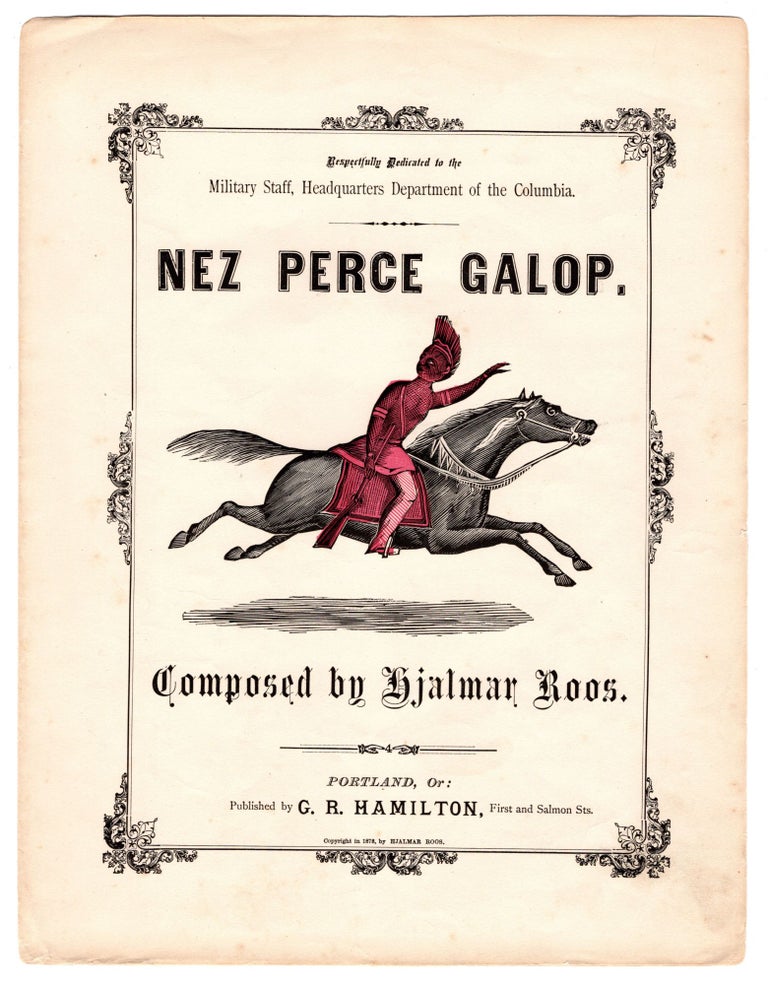Respectfully Dedicated to the Military Staff, Headquarters Department of the Columbia. Nez Perce Galop.
Portland, OR: Published by G.R. Hamilton, First and Salmon Sts., 1878. Illustrated sheet music, 10.75” x 14”, picturing a Nez Perce warrior on horseback, printed in red and black, within ornamental border [6] pp. including front cover and three pages of musical score (no lyrics). Back cover is blank. CONDITION: Very good, light toning and wear to edges. A rare piece of sheet music commemorating the Nez Perce War, published in Portland, Oregon shortly afterwards, dedicated to the officers of the Department of the Columbia, and picturing a Nez Perce warrior on horseback, apparently in the act of fleeing the U.S. Army. The War was made famous by the amazing retreat in 1877 of several bands of "non-treaty" Nez Perce, led by Joseph, Ollokot (Joseph's brother), White Bird, Looking Glass and several other leaders, as they made their way almost 1,200 miles from Oregon and Idaho to Canada to escape the retribution of the U.S. Army. The Nez Perce Treaty of 1855 allocated the many bands of the Tribe some 7.5 million acres of land that was part of their much larger native homeland. However, after the discovery of gold in part of their land in Idaho in 1860, tensions mounted between miners and the Nez Perce. In 1869, the U.S. Government broke the original treaty and took away nearly ninety percent of the original land and opened it up for mining and settlement by forcing portions of the Nez Perce tribe to sign the new treaty. Several bands did not sign, and became known as the "non treaty" Nez Perce. In 1877, in retaliation for the ignored killing of several Indians, members of the non-treaty Nez Perce attacked white settlers. The U.S. Army was called upon to force the non-treaty bands onto the reservation. Refusing to be corralled, the leaders of the non treaty Nez Perce, including Chief Joseph, initiated a long trek to join Sitting Bull, who after Little Big Horn, had fled to Canada. Some 250 warriors and more than 500 women, children and older adults, along with close to 2,000 horses and other livestock, began the retreat in May, 1877. They were pursued by U.S. Army troops under the command of General Oliver Otis Howard of the Department of the Columbia. The small band of warriors fought several battles and skirmishes, which captured the imagination of of the public, as the non-treaty Nez Perce made their way over the Rockies, down through Yellowstone, and north towards the Canadian border. Both the army and the Nez Perce suffered casualties between May and October. Finally, only 40 miles from the border, General Nelson A. Miles intercepted the Nez Perce and attacked their encampment. Joseph surrendered on October 5, 1877, delivering his now-famous “I will fight no more forever" speech. Although the Army generals, in accepting the surrender, promised that the Nez Per could go back to their homelands, the Indians were eventually sent to Fort Leavenworth, Kansas. They would not return to their ancestral homeland until well into the 1880s. In the process of the Nez Perce retreat, the non-treaty bands became folk heroes to many. Chief Joseph, although he was only one of several chiefs in the group, became nationally known and revered by non-native Americans. Newspapers that initially made the Nez Perce out to be ferocious savages, were filled with admiration for the bands perseverance in the face of the odds against them, their fighting strategies, and their care for the women and children. No copies recorded in WorldCat. Oregon Historical Society has a copy.
Item #7386
Sold


